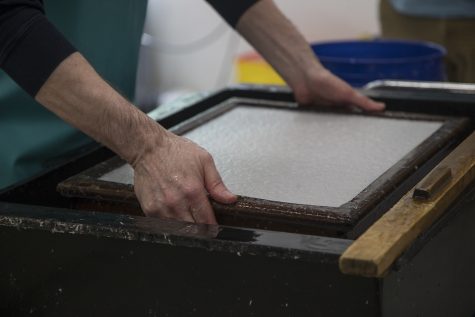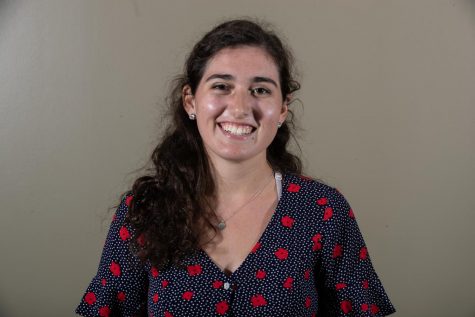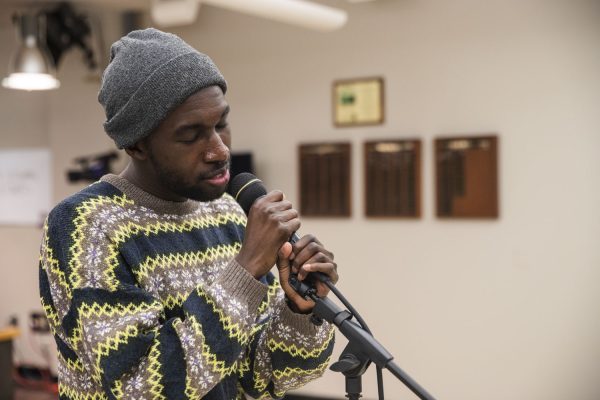Papermaking master a gem in a digital age
The University of Iowa houses one of the world’s leading papermakers, and he is teaching the lost art.
Director of The Center for the Book Timothy Barrett shifts paper pulp during a paper-making demonstration at the Center for the Book in North Hall on June 18, 2019. Graduate students were shown how to shift pulp to create sheets of paper. (Katie Goodale/The Daily Iowan)
June 25, 2019
In the digital age, has paper become outdated?
With the creation of ebooks, email, and online news, most of the recent generation might have a different connection to the material than some from older generations. But a University of Iowa faculty member has not just found the material to be beautiful, he has devoted his life’s work to its creation.
“We have been taking it for granted for so long, and that is partly because it has been around for so long,” Director of the Center of the Book and master papermaker Tim Barrett said. “It’s almost like we have discovered it anew or taken it seriously.”
There are not many people who can describe something such as making paper by hand and have it sound beautiful, but that’s not the case for Barrett.
“People often ask me, ‘So you don’t like to draw on this paper or make prints?’ No no no,” Barrett said. “I’m just interested in making the paper. I’m a little bit unusual that way.”

Director of The Center for the Book Timothy Barrett shifts paper pulp over a mold to create a page during a paper-making demonstration at the Center for the Book in North Hall on June 18, 2019. Graduate students were shown how to shift pulp to create sheets of paper. (Katie Goodale/The Daily Iowan)
He has been with the UI since 1986 with one goal in mind: to study the process and create handmade paper, and he has done quite an accomplished job of it.
Barrett’s research has been funded by such organizations as the U.S. Institute of Museum and Library Services, and in 2009, he won a prestigious MacArthur Fellowship, often called by its unofficial name, “Genius Grant,” an award that is only given to experts who have not only made strides in their field but have a strong possible to continue to have a large effect.
Barrett has made a name for himself in the international papermaking world, with more than 40 years of experience.That fascination with paper started when he was a teenager in Kalamazoo, Michigan.
“I noticed early on that some papers are boring,” he said. “I got interested in the aesthetics really early even though I’m talking about a flat sheet of paper, nothing decorated or colored.”
With the city having many industrial paper mills, he was curious about the history of paper and books in general. After asking his father, an English and American literature teacher, he got the basics and soon took to his high-school library and found a book by world-renowned papermaker Dard Hunter, who wrote many books about the process of papermaking.
“When I got ahold of those, I was like, ‘Wow, this is like Ali Baba’s cavern,’ ” Barrett said. “I was just captivated by it, partly, I guess, because no one else was doing it.”
This knowledge launched Barrett into a degree in art communications, and two years in Japan with a Fulbright Fellowship to study papermaking. Fast-forward a few decades from the start of his paper venture, he has written a book about Japanese papermaking with another one in the tank and was part of a conservation team that help archive historical documents such as the Declaration of Independence.
His career has had a large impact in the world of paper and beyond.

Director of The Center for the Book Timothy Barrett presses his paper mold to a felt sheet during a paper-making demonstration at the Center for the Book in North Hall on June 18, 2019. Graduate students were shown how to shift pulp to create sheets of paper. The paper pulp will stick to the felt and come loose from the frame with pressure. (Katie Goodale/The Daily Iowan)
“We’re extremely lucky here at the University of Iowa to have the Center of the Book and a master papermaker,” said Duncan Stewart, an adjunct instructor of rare books and special collections. “When you’re dealing with rare books, one of the most important things is the type of paper. So understanding how the paper was made helps you understand how the book was put together.”
The UI and Iowa City have benefited from having both the Center of the Book and Barrett.
“It pretty much straddles the university and city community; there are students that come here to study with Tim, but then there are all sorts of local presses who benefit from Tim’s presence as well as the students Tim brings,” English Professor Loren Glass said. “So Tim’s presence and the Center of the Book [have] sparked local developments that really benefit the community as well.”
With a world that is becoming more allured by the physical than the digital, Barrett’s craft lends itself to this generation, with global paper consumption growing from 370.8 metric tons to 413.6 metric tons..
“I think that we really like having our art having some sort of material manifestation in the world,” Glass said. “Lots of people who keep predicting the death of the book are always wrong. Go to any bookstore — you see huge stacks of books, and lots of people are still buying physical books.”
Barrett said he considers himself not an artist but an artisan. To have such a focus on the craft in such a niche trade as papermaking for decades can be a long road until one finds the rewards of the work.
“I think if you pursue something that you’re passionate about, you’re likely going to be living on the edge for a long time compared to your peers,” Barrett said. “But when it’s all said and done, chances are your life will be more rewarding than theirs.”















